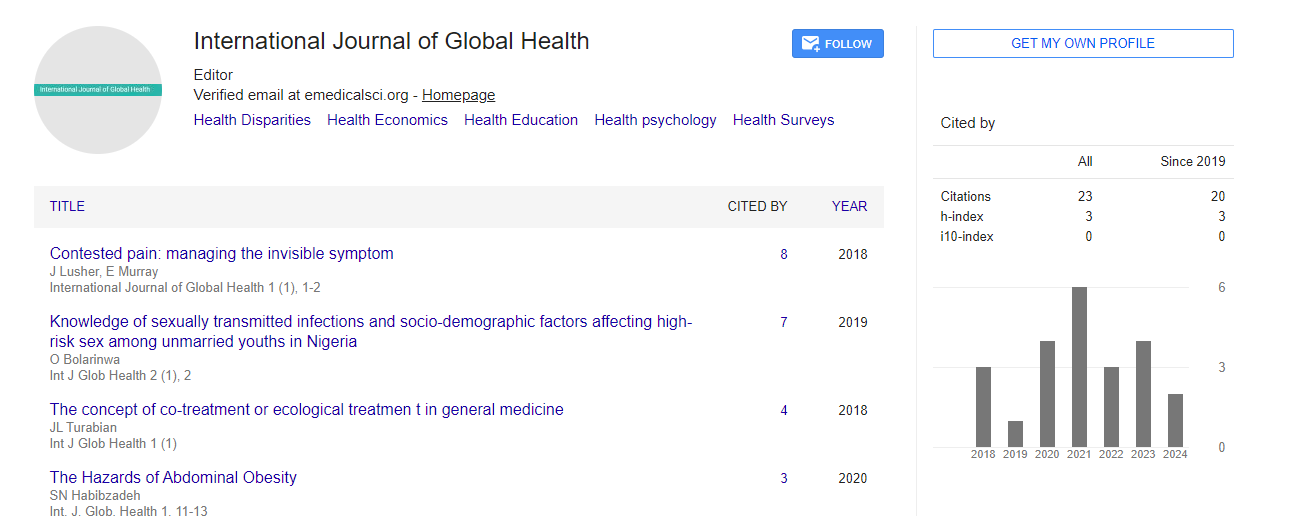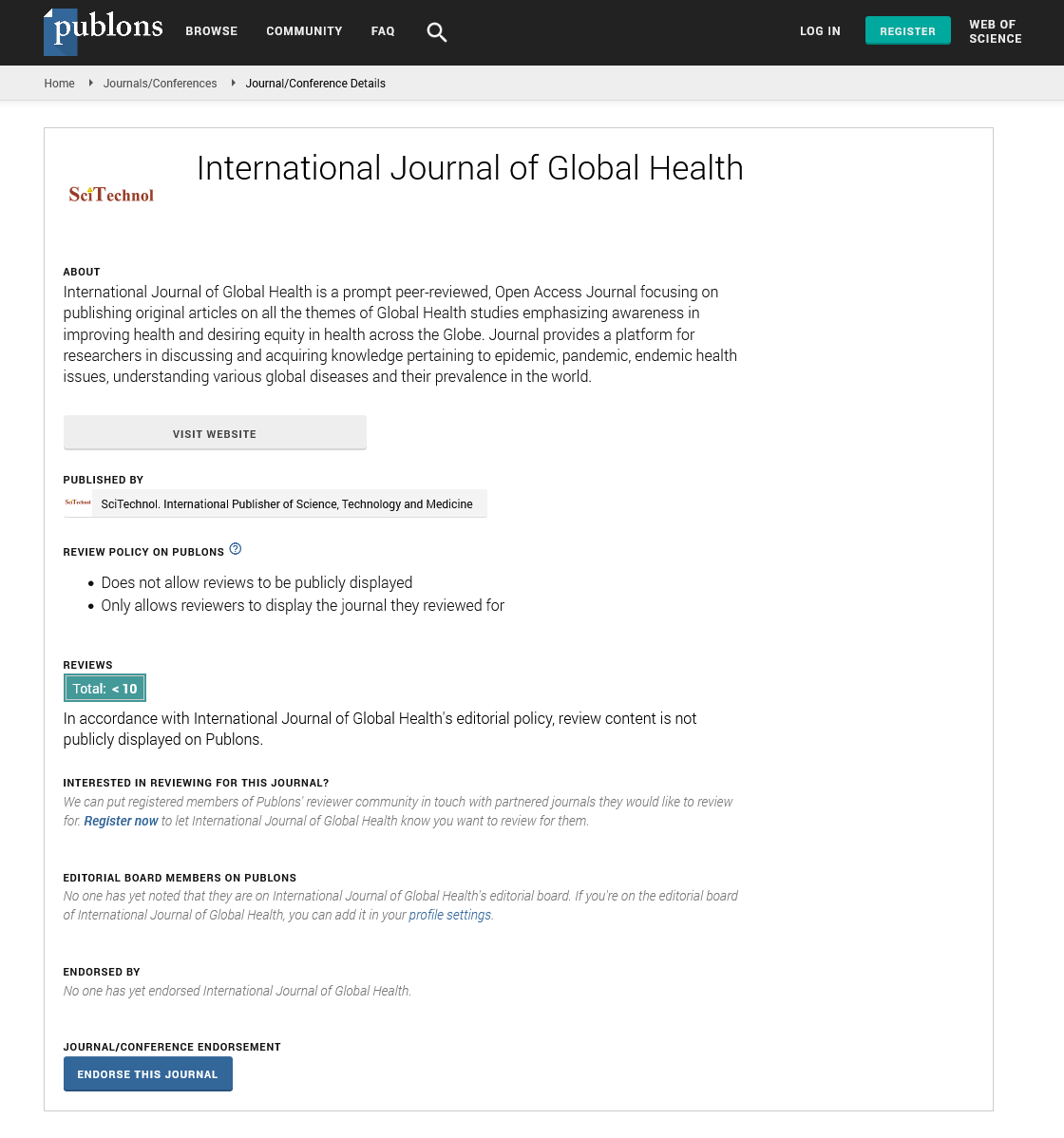Editorial, Int J Glob Health Vol: 1 Issue: 1
Today’s Global Health Profile and Tomorrow’s Perspective
Hamid yahya Hussain*
Consultant, World Health organization, UAE
*Corresponding Author : Hamid yahya Hussain
Consultant, World Health organization, UAE
E-mail: hyHussain@dha.gov.ae
Received: January 03, 2018 Accepted: January 04, 2018 Published: January 09, 2018
Citation: Hussain HY (2018) Today’s Global Health Profile and Tomorrow’s Perspective. Int J Glob Health 1:1.
Abstract
When the Summit of 2000 held by United Nations, Global interventions to improve world population health and wellbeing was among the top of summit agenda, declared by member nations called Millennium Development Goals (MDGs). Declaration that included significant difficulties encountering global development, aimed to almost by 2015. Accordingly, such as mid-decade Goals (MDGs) utilized as fundamental base and essential frame for development. Remarkable achievements have been made in many of areas. Nevertheless, mid decades goals stayed un-addressed and achieved like such as reproductive health, maternal health and child health as well as many others, saying that developmental goals renewal agenda was made to cover about 17 Goals of sustainable development to be achieved through out 2016-2030. Poverty and related diseases eradication was among the top of the priorities. New agenda with title of transforming our world has been developed to be reached by 2030 as a vision to sustainable development.
Keywords: Fortification; Salt iodization; Hygiene interventions
When the Summit of 2000 held by United Nations, Global interventions to improve world population health and wellbeing was among the top of summit agenda, declared by member nations called Millennium Development Goals (MDGs). Declaration that included significant difficulties encountering global development, aimed to almost by 2015. Accordingly, such as mid-decade Goals (MDGs) utilized as fundamental base and essential frame for development. Remarkable achievements have been made in many of areas. Nevertheless, mid decades goals stayed un-addressed and achieved like such as reproductive health, maternal health and child health as well as many others, saying that developmental goals renewal agenda was made to cover about 17 Goals of sustainable development to be achieved through out 2016-2030. Poverty and related diseases eradication was among the top of the priorities. New agenda with title of transforming our world has been developed to be reached by 2030 as a vision to sustainable development.
As 2015 approached, a new book concerning hot and pressing global health concerns titled “To Save Humanity” was published, hundreds of politic with global figures and science, covered a wide scope of interests like immunizations, antibiotic resistance, Universal health access and coverage, Smoking and wide consumption of tobacco, methodology of research, progressive changes of climate, equity and equality access to medications as well as media coverage of health research.
Significant and wide range health interventions on Global base, been applied so as to improve the health of children and their survival by many strategies e.g. promoting of breastfeeding option, supplementation of Zinc, fortification with Vitamin A, iodization of salt, hand-washing intervention and hand hygiene, immunization, and adequate management of acute malnutrition. About 32 treatments strategies and health interventions proposed by The Global Health Council has effective impact on save several million lives each year.
Due to inequity and inequality in cohorts with adequate access to medical treatment compared to those who do not most of the target population encounter an “outcome gap”, that address the gap among a significant sustainable infrastructure lack Countries. In many countries worldwide like Guatemala, a subset of the public sector, (“Program for Access to Medicines”), revealed lowest average availability (25%) as compared to the private sector (35%). It has been shown that private sector, witnessed highest- and lowest-priced medicines were 22.7 and 10.7 times as more expensive as compared to international reference prices respectively. Unaffordable medicine is quite familiar finding, costing about 15 days wages for a course like ceftriaxone antibiotic. Yet in spite of public sector in Pakistan, revealed good access to medicines at a lower price than international reference prices, but a remarkable and chronic shortage of and lack of access to basic medicines.
There have been lots of arguments that, suffering from lack of fund, rather is not the main problem of global health, rather, global health, plagued by the dilemma such as funds are always abused and do not always translate into positive outcomes. The gap is always lying in how, such funds are distributed and invested, it shows that there are disproportionately allocated to encounter and manage a single disease. Report by World health organization 2006 highlighted that a shortage of health care professionals and health givers was almost (4.3) million nurses, physicians, midwives, and other health care workers support workers worldwide, significantly more in certain areas like sub-Saharan Africa.
No borders recognized by Disease. In current world, they are strongly linked and connected any single disease threat at any time and place can become a health threat worldwide. By ease and fastly moved people around the globe, rapidly expanding commerce and trade can be affected even by the smallest gap to spread and grow along with. There is huge need to close open ways available to infectious disease into all continents is much more significant of today than ever before.
One of the most cost effective –mechanism to protect world population from important health threats like Ebola, Zika as well as pandemic influenza, is basically by early Detects and containment of the outbreaks through their source, to saving lives and decreasing healthcare costs. World health organization, CDC, and many other international NGOs remain the main players in steering global health taskforces around the globe to capacity building, to preventing, detecting, and responding to their health threats through our work. The destination is to control diseases where they take place as early as they start.
There are many global health programs operating currently worldwide, in the history of public health, global health considered to be as the major commitment by any country to combat a single disease, developing and expanding the infrastructure which is essential to deliver prevention, care, and treatment services in low resource settings. As per case of Malaria, HIV/AIDS, tuberculosis related morbidities and mortalities.
Working at global level to eliminate the world of vaccinepreventable diseases like polio, Measles, influenza, hepatitis, to a certain children no more repeating the tragedy history as people with polio had to be in iron lungs to breathe, and the children had to stay their summer indoors in fear of being paralyzed for life.
Current Global health operations and efforts all over the world are truly contributed to make human being life more secure and safe , yet the fragmentations and multiple players investment models, frequently impact outcome quality and quantity, world contributors needs to develop highly coordinated, one way solidarity and unified vision in approaching global health risks and threats.
 Spanish
Spanish  Chinese
Chinese  Russian
Russian  German
German  French
French  Japanese
Japanese  Portuguese
Portuguese  Hindi
Hindi 
